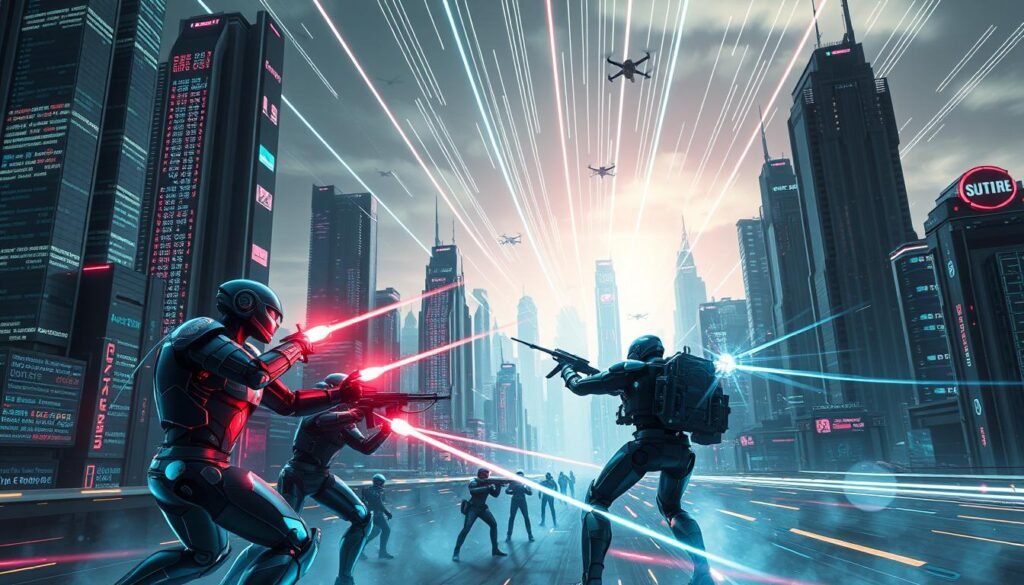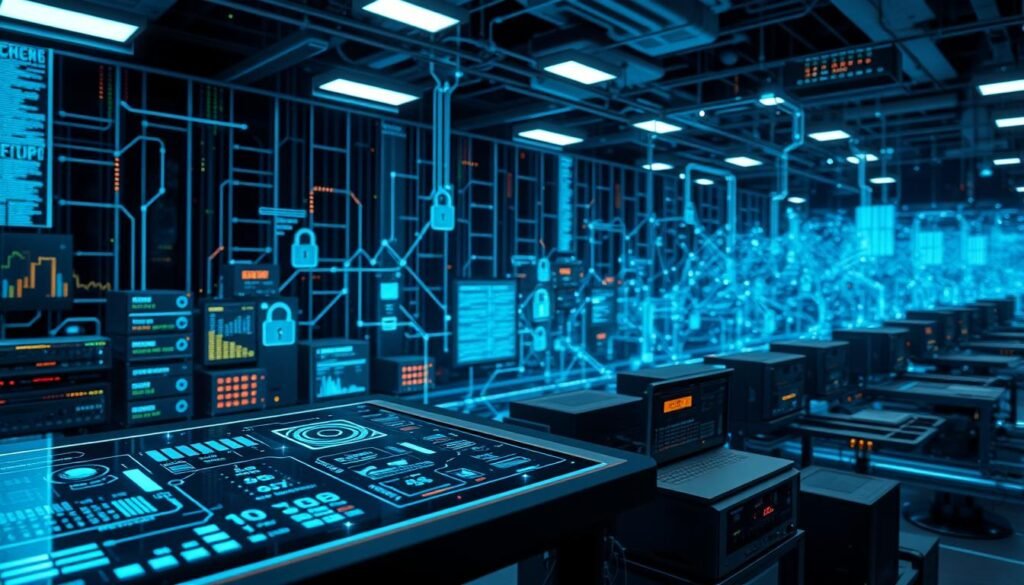Cyber Security vs Artificial Intelligence is one of the most important debates in today’s digital world. A big question remains: Can our defenses against cyber threats keep pace with the evolving landscape of technology?
The internet has changed a lot since the 1970s. What was once considered safe is now full of threats, as malware and attackers constantly look for weak spots to steal sensitive information.
The intersection of cyber security and artificial intelligence is critical. Both play a vital role in protecting data, strengthening defenses, and ensuring trust in our digital future.
Key Takeaways
- The internet’s growth has led to more cyber threats.
- Strong security is needed in today’s digital world.
- Understanding the differences between cyber security and AI is important.
- AI’s role in cyber security is crucial.
- We need better security solutions now.
The Fundamental Nature of Cyber Security and AI
Cyber security and artificial intelligence are changing fast. Cyber security protects digital systems and data from threats. AI uses data to automate tasks and make better decisions.

Core Principles of Cyber Security
Cyber security has three main principles: confidentiality, integrity, and availability (CIA triad). Confidentiality means only authorized people can see sensitive info. Integrity keeps data accurate and complete. Availability means data and resources are there when needed.
To keep systems safe, we use firewalls, encryption, and intrusion detection systems. These tools fight off malware, phishing, and DoS attacks.
Core Principles of Artificial Intelligence
Artificial intelligence makes machines smart like humans. It’s based on machine learning, natural language processing (NLP), and computer vision. Machine learning lets systems get better over time. NLP helps machines understand and create human language. Computer vision lets AI systems see and make decisions based on what they see.
AI needs lots of data and complex algorithms to work well. Deep learning and neural networks are key for tasks like image and speech recognition, and predictive analytics.
Initial Points of Comparison
Comparing cyber security and AI, we see some key differences. Both rely on data and tech, but their goals are different. Cyber security is all about defense, protecting digital assets. AI aims to improve systems by automating tasks and making smart decisions.
| Feature | Cyber Security | Artificial Intelligence |
|---|---|---|
| Primary Objective | Protect digital assets from threats | Enhance system capabilities through automation and intelligent decision-making |
| Key Technologies | Firewalls, encryption, intrusion detection systems | Machine learning, NLP, computer vision |
| Methodologies | Threat analysis, risk management, incident response | Data analysis, model training, predictive analytics |
Historical Evolution and Development
The world of technology has changed a lot because of cyber security and artificial intelligence. These two fields have grown more complex and are now closely linked.
The Birth and Growth of Cyber Security
Cyber security started early in computing, when threats first appeared. At first, security was simple, focusing on physical protection and basic controls. But as the internet grew, so did the need for better security.
Today, cyber threats range from simple viruses to complex attacks. This shows how important cyber security has become.
“The cybersecurity landscape is constantly evolving, with new threats emerging daily,” experts say. This highlights the need for ongoing innovation in cyber security.

The AI Journey: From Concept to Reality
Artificial intelligence has come a long way from its early ideas. It started with trying to make algorithms that think like humans. Now, thanks to better computers and storage, AI can learn and adapt.
AI is now used in security to detect and respond to threats. It uses machine learning to spot patterns and anomalies that humans might miss.
Convergent Evolution Points
Cyber security and AI have merged in important ways. AI helps make cyber security better, like with predictive analytics and automated systems. This mix is making security stronger but also brings new challenges.
The future of cyber security depends on AI advancements. As AI gets better, we’ll see more advanced security solutions. These will help tackle the complex cyber security challenges we face.
Cyber Security vs Artificial Intelligence: Key Differences
Cyber security and artificial intelligence have different main goals. Cyber security protects computer systems and networks from threats. Artificial intelligence works on making machines smart enough to do tasks that humans do.

Fundamental Objectives and Focus Areas
Cyber security keeps digital info safe from unauthorized access. It uses tools like firewalls and encryption. Artificial intelligence, on the other hand, aims to make machines think like humans.
Cyber security focuses on threat analysis and keeping info safe. AI works on learning from data and making smart decisions. These are two different paths.
Methodological Approaches and Frameworks
Cyber security uses risk management and follows rules to keep systems safe. It relies on frameworks like NIST and ISO 27001. Artificial intelligence, though, uses data and algorithms to learn and make decisions.
AI uses frameworks like TensorFlow to build models. Its approach is to collect data, train models, and refine them for better results.
Implementation Requirements and Challenges
Setting up good cyber security needs to know threats and have strong systems. It’s hard to keep up with new threats and manage complexity. Cyber security also has to follow rules.
AI needs quality data and powerful algorithms to work. It faces challenges like data bias and making sure AI decisions are fair. It also needs to handle the ethics of AI.
Core Technologies in Cyber Security
The heart of modern cyber security is its core technologies. They protect digital assets from threats. These technologies form a strong defense against cyber attacks.

Network Security Infrastructure
Network security is key in cyber security. It uses hardware and software to guard networks and data. Firewalls, intrusion systems, and VPNs are part of this.
These tools block unauthorized access, detect threats, and keep data safe. They ensure data stays secure as it moves over the network.
- Firewalls block unwanted traffic between networks.
- Intrusion detection systems watch for unauthorized access or malicious activity.
- VPNs create a secure, encrypted link between two points on the internet.
Encryption and Authentication Methods
Encryption and authentication protect data and ensure only authorized access. Encryption makes data unreadable to prevent unauthorized access. Authentication methods, like passwords and biometrics, check who or what is trying to access.
- Symmetric encryption uses the same key for both encryption and decryption.
- Asymmetric encryption uses a pair of keys: one for encryption and another for decryption.
- Multi-factor authentication requires more than one method of authentication to access a system or data.
Threat Intelligence and Monitoring Systems
Threat intelligence collects and analyzes data on potential threats. Monitoring systems detect and respond to security incidents in real-time. They offer real-time threat detection and incident response.
Effective cyber security combines these core technologies. Understanding and using these technologies helps organizations defend against cyber threats.
Foundational Technologies in Artificial Intelligence
The core of artificial intelligence is built on key technologies. These include machine learning algorithms and natural language processing. They help AI systems understand complex data, make smart choices, and get better over time.
Machine Learning Algorithms and Approaches
Machine learning is a key part of AI. It lets systems learn from data without being told how. There are three main types: supervised learning, unsupervised learning, and reinforcement learning.
Supervised learning is used for tasks like image classification and speech recognition. It’s trained on labeled data. Unsupervised learning is for tasks like clustering and dimensionality reduction. It finds patterns in data without labels.
Neural Networks and Deep Learning
Neural networks are inspired by the brain. Deep learning uses many layers to handle complex data. It’s led to top results in areas like computer vision, natural language processing, and speech recognition.
“Deep learning is a key technology that has enabled the recent advances in AI, allowing for the analysis of complex data and the achievement of human-like performance in various tasks.”
Natural Language Processing and Computer Vision
Natural Language Processing (NLP) lets computers understand and create human language. NLP techniques like tokenization, named entity recognition, and sentiment analysis are key for tasks like chatbots, language translation, and text summarization.
Computer Vision is another important AI technology. It lets computers understand visual information. Computer Vision techniques are used in tasks like object detection, facial recognition, and image segmentation.
- NLP enables computers to understand human language.
- Computer Vision allows computers to interpret visual data.
- Both technologies are crucial for developing intelligent systems.
Professional Skill Requirements and Career Paths
Digital technologies are growing fast, making careers in cyber security and AI more important. Both fields offer exciting and meaningful paths in tech. They come with unique challenges and need different skills.
Cyber Security Professional Profile
Cyber security experts protect computer systems, networks, and data from threats. They need to know about network security, cryptography, and threat analysis. Important skills include security frameworks, risk management, and how to handle incidents.
Critical skills for cyber security professionals:
- Knowledge of security protocols and threat intelligence
- Experience with security information and event management (SIEM) systems
- Understanding of compliance and regulatory requirements
AI Developer and Researcher Profile
AI developers and researchers create intelligent systems that can do human-like tasks. They must know machine learning, neural networks, and programming languages like Python or R. Key skills include data modeling, algorithm development, and understanding complex data.
Essential skills for AI professionals:
- Proficiency in machine learning frameworks and deep learning
- Experience with natural language processing and computer vision
- Strong analytical and problem-solving skills
Overlapping Competencies and Hybrid Roles
As cyber security and AI evolve, the need for professionals who know both grows. Hybrid roles combine skills from both areas. They involve understanding AI threats and creating AI security solutions.
Emerging hybrid roles:
- AI security specialist
- Cyber security data scientist
- Threat intelligence analyst with AI expertise
The mix of cyber security and AI is opening up new career paths and challenges. Those who can work in both fields are in high demand. Their skill in using AI to solve security problems is key in today’s digital world.
Industry Applications of Cyber Security
Cyber security is key in many industries like finance, healthcare, and government. As tech grows, so does the need for strong cyber security. This is true across various sectors.
Financial Sector Security Implementations
The financial world is a big target for hackers because of the sensitive info it holds. To fight this, banks and financial firms use top-notch cyber security. They focus on:
- Advanced Threat Detection: They use machine learning to spot and stop threats fast.
- Encryption: They keep data safe with strong encryption, both when it’s stored and when it’s moving.
- Regular Security Audits: They check their systems often to find weak spots and make their security better.
Healthcare Data Protection Strategies
The healthcare field is also a big target for hackers because of the personal info it keeps. To keep this info safe, healthcare places use several strategies. These include:
- Data Access Controls: They make sure only the right people can see important data.
- Patient Data Encryption: They encrypt patient data to stop unauthorized access.
- Incident Response Plans: They have plans ready to deal with data breaches and lessen their damage.
Government and Defense Security Applications
Government and defense groups are also big targets for cyber attacks. They use advanced cyber security to protect themselves. Some of these measures are:
- Cybersecurity AI Implementation: They use AI to improve their ability to find and handle threats.
- Network Segmentation: They divide their networks to stop malware and unauthorized access from spreading.
- Continuous Monitoring: They keep a close eye on their networks and systems for any security issues.
Industry Applications of Artificial Intelligence
AI is changing many industries, from business and healthcare to transportation. It’s driving innovation and making things better. As AI gets better, it’s being used in more ways, changing old ways of doing things and opening up new opportunities.
AI in Business and E-commerce
In business and e-commerce, AI is making customer experiences better, making things run smoother, and helping make decisions. AI-powered chatbots offer 24/7 customer support. predictive analytics helps businesses see trends and make smart choices.
Here are some key AI uses in business and e-commerce:
| Application | Description | Benefits |
|---|---|---|
| Customer Service Chatbots | AI-driven chatbots for customer support | 24/7 Support, Reduced Response Time |
| Predictive Analytics | AI-based forecasting and trend analysis | Informed Decision-Making, Improved Forecasting |
| Personalized Marketing | AI-driven personalized marketing campaigns | Enhanced Customer Engagement, Increased Conversion Rates |
AI in Healthcare Diagnostics and Treatment
In healthcare, AI is changing how we diagnose and treat patients. AI algorithms can look at medical images to find problems. predictive models help find patients at risk and create treatment plans just for them.
AI in Transportation and Smart Cities
AI is also making transportation better, with smart traffic management, self-driving cars, and better routes. AI-powered systems can predict and stop traffic jams. autonomous vehicles are being tested for safer, more efficient travel.
AI in transportation is helping build smart cities. It’s making life better for city residents. As AI keeps getting better, we’ll see even more cool uses in transportation.
The Intersection: AI-Powered Cybersecurity
The mix of AI and cybersecurity is changing how we fight threats. As cyber attacks get smarter, AI in security systems is making a big difference.
Machine Learning for Threat Detection
Machine Learning (ML) is a key part of AI helping in threat detection. It looks at lots of data to find patterns and oddities that might mean trouble. This helps security systems spot and act on threats fast.
- Anomaly Detection: ML finds unusual behavior that could mean a cyber attack.
- Predictive Analytics: ML uses past data to guess future threats, helping to act early.
- Improved Accuracy: ML gets better over time, cutting down on false alarms.
Automated Security Response Systems
AI-powered systems can respond to threats quickly, reducing the time attackers have. They can:
- Isolate Affected Systems: Fast isolation stops malware from spreading.
- Initiate Countermeasures: They start actions to lessen the threat right away.
- Notify Security Teams: They alert human teams for deeper checks and actions.
Predictive Security Measures and Threat Intelligence
AI helps predict threats by analyzing lots of data. This lets organizations:
- Stay Ahead of Threats: Guess where and how attacks might come.
- Enhance Security Posture: Improve security steps to face expected threats.
- Optimize Incident Response: Plan responses based on likely attack paths.
AI in cybersecurity is not just a trend; it’s essential against smarter cyber threats. Using AI for detection, response, and prediction boosts security a lot.
Challenges in Modern Cyber Security
The world of cyber threats is always changing. As technology gets better, so do the threats. This means cyber security must keep up and get better too.
The Evolving Threat Landscape
New threats pop up every day in cyber security. Advanced Persistent Threats (APTs) and zero-day exploits are big challenges. They make it hard for cyber security experts to stay ahead.
The use of Artificial Intelligence (AI) and Machine Learning (ML) has made threats smarter. AI malware can change and avoid being caught. This makes it tough for old security methods to work.
| Threat Type | Description | Impact |
|---|---|---|
| Advanced Persistent Threats (APTs) | Sophisticated, targeted attacks by organized groups | Significant data breaches and financial loss |
| Zero-Day Exploits | Attacks that exploit previously unknown vulnerabilities | High impact due to lack of preparedness |
| AI-Powered Malware | Malware that uses AI to adapt and evade detection | Increased difficulty in detection and mitigation |
Resource and Expertise Constraints
Cyber security has big challenges because of a lack of resources and experts. There are not enough skilled people to fight the growing number of threats.
Also, cyber threats change fast. Cyber security workers need to keep learning to stay ahead of new threats.
Human Factors and Social Engineering
Human weaknesses and social engineering attacks are big problems. Tactics like phishing and pretexting target people, not just technology. This makes them hard to stop.
To fight these attacks, we need to teach people about the dangers. Training and awareness programs can help protect against social engineering.
Limitations and Ethical Concerns in AI
AI is becoming more common in many areas. It’s important to talk about its limits and ethical issues. We need to understand these challenges to use AI safely and well.
Data Quality, Bias, and Fairness Issues
AI relies a lot on good data. Data bias can cause unfair results and discrimination. It’s key to find and fix bias to use AI ethically.
- Implementing robust data validation processes
- Using diverse data sets to train AI models
- Regularly auditing AI systems for bias
Also, data privacy is a big deal. AI needs lots of personal data, which raises questions about how it’s used.
Computational and Environmental Costs
AI systems need a lot of computing power. This uses a lot of energy and harms the environment.
Some important things to think about are:
- Improving the energy efficiency of AI systems
- Developing more environmentally friendly AI training methods
- Assessing the carbon footprint of AI operations
Governance, Privacy, and Ethical Frameworks
Strong governance frameworks are needed for AI’s ethics. We need rules for AI’s development, use, and deployment. And we must follow current laws.
Important parts of good governance are:
- Transparency in AI decision-making processes
- Accountability for AI system outcomes
- Regular review and update of AI governance policies
By tackling these issues, we can make AI development more responsible and green.
Future Trends: The Convergence of Cyber Security and AI
The use of AI in cyber security is changing how we fight threats. As our world gets more connected, cyber security and AI will be key to keeping our digital stuff safe.
Emerging Technologies and Methodologies
New tech like Machine Learning (ML) and Deep Learning (DL) will shape cyber security’s future. These tools will help create better systems to find and stop complex threats.
- Advanced threat detection using ML and DL
- Automated security response systems
- Predictive security measures and threat intelligence
Industry Transformation and New Paradigms
The mix of cyber security and AI will change industries a lot. New ways of doing things will come up because we need smarter, stronger security.
| Industry | Current Cyber Security Approach | Future AI-Driven Approach |
|---|---|---|
| Financial Sector | Traditional rule-based security systems | AI-powered threat detection and response |
| Healthcare | Manual monitoring and incident response | Automated security information and event management |
| Government | Signature-based threat detection | Behavioral analysis and anomaly detection |
Preparing for the Future Integrated Landscape
To get ready for the future, companies need to invest in AI-driven cyber security solutions. They must also build the skills and systems needed for cyber security and AI to work together.
By going this route, companies can keep up with threats and better protect their digital assets.
Conclusion
It’s key to know the differences and similarities between cyber security and artificial intelligence. This knowledge helps us create better security and use AI to boost cyber safety. As tech grows, knowing how these areas work together will be more important.
Using artificial intelligence in cyber security can change how we find and deal with threats. With machine learning and predictive analytics, companies can get better at security. They can also stay one step ahead of new dangers.
Looking ahead, we must see the value in both cyber security and artificial intelligence. Even though they’re different, they work together. By understanding them, we can make our digital world safer and stronger.



